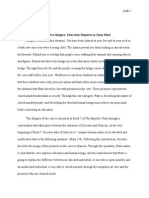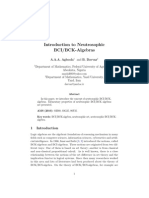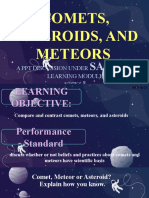Professional Documents
Culture Documents
Study Questions For Plato's "The Allegory of The Cave": Context
Study Questions For Plato's "The Allegory of The Cave": Context
Uploaded by
lydiaOriginal Description:
Original Title
Copyright
Available Formats
Share this document
Did you find this document useful?
Is this content inappropriate?
Report this DocumentCopyright:
Available Formats
Study Questions For Plato's "The Allegory of The Cave": Context
Study Questions For Plato's "The Allegory of The Cave": Context
Uploaded by
lydiaCopyright:
Available Formats
Study Questions for Plato’s “The Allegory of the Cave”
Please write out your answers to the questions that follow and/or take notes
on the relevant areas in the text. It is best to get into the habit of doing this
while reading. You should complete this exercise after you have read and
highlighted, or noted, areas of the text that you think are important. The
purpose of this exercise is to help you follow the author’s intent and to think
critically about his arguments. Below are a list of questions that, once
answered, will ensure that you have a good outline of the story’s purpose and
an in-depth understanding of its historical importance.
Context:
The Allegory of the Cave, also known as The Myth of the Cave, is Classical
Greek philosopher Plato’s most famous and ingenious composition. It occurs
in the seventh book of The Republic, the magnum opus of his political
philosophy. Plato’s The Republic, particularly The Allegory of the Cave, is
instrumental in the development of traditional Western philosophy, particularly
for the introduction to a fundamental and abiding theme in philosophy, “the
essence of truth.”
The Allegory of the Cave is a parable designed by Plato to illustrate the power
of philosophy to free and enlighten men. This narrative unfolds Plato's
notions about the structure of the world and “the essence of truth,” challenging
many of our conceptions of the cosmos and political beliefs. In this allegory,
abstract thinking is portrayed as the key element which holds access to real
truth. Building upon the teachings of his mentor, Socrates, The Allegory of
the Cave represents Plato's own reflections on the origin, nature, methods,
and limits of human knowledge (epistemology), as well as on the real nature
of things (metaphysics).
Questions:
1. How does The Allegory of the Cave illustrate Plato’s view of the physical world?
2. According to Plato, how can we find the “true essence” of an object?
3. In this parable, how is the human soul described?
4. How does the allegory describe the process of acquiring knowledge?
5. After reading this allegory, how do you think Plato would describe “happiness?”
Saylor URL: www.saylor.org/courses/hist101/#5.3.5
The Saylor Foundation Saylor.org
Page 1 of 2
6. Who are the “people chained in the cave?”
7. According to The Allegory of the Cave, how should the process of education be
approached?
8. According to The Allegory of the Cave, what is the main task of the philosopher?
9. Who are the “guardians” or philosopher-kings?
10. Why should philosopher-kings rule?
11. How does Plato’s The Allegory of the Cave relate to science and scientific research?
Saylor URL: www.saylor.org/courses/hist101/#5.3.5
The Saylor Foundation Saylor.org
Page 2 of 2
You might also like
- Philosophy Textbook Chapter 01Document22 pagesPhilosophy Textbook Chapter 01Sukhveer SangheraNo ratings yet
- Study Guide Sophies WorldDocument36 pagesStudy Guide Sophies WorldGlorden Mae Ibañez SalandananNo ratings yet
- Manifesto For The NoosphereDocument8 pagesManifesto For The NoosphereMona RabieNo ratings yet
- From Ancient To Postmodern AstrologyDocument22 pagesFrom Ancient To Postmodern AstrologyNabanita JavedNo ratings yet
- Worldview Defhistconceptlect PDFDocument50 pagesWorldview Defhistconceptlect PDFbilkaweNo ratings yet
- Mickey WateractivityDocument3 pagesMickey Wateractivityapi-293006069No ratings yet
- Heluo Hill Table of Contents Workbook 9 Star Ki DivinationDocument17 pagesHeluo Hill Table of Contents Workbook 9 Star Ki Divinationm mahfoudNo ratings yet
- PhilosophyDocument12 pagesPhilosophyDARREN ESPANTONo ratings yet
- Reading Guide Allegory of The CaveDocument2 pagesReading Guide Allegory of The CavenoirethyxNo ratings yet
- FA 13 - PHI 421 Final Exam Study Guide Answer KeyDocument14 pagesFA 13 - PHI 421 Final Exam Study Guide Answer KeyJeff WilliamsNo ratings yet
- WeekDocument3 pagesWeekElla Mae EchalasNo ratings yet
- Benita (PHILOSOPHY)Document13 pagesBenita (PHILOSOPHY)Seibide ImporteeNo ratings yet
- Allegory of The CaveDocument3 pagesAllegory of The CavejieunNo ratings yet
- Plato Research Paper TopicsDocument7 pagesPlato Research Paper Topicsgooietrif100% (1)
- Earthly Knowledge Is But A Shadow: Plato's Theory of Recollection in The MenoDocument17 pagesEarthly Knowledge Is But A Shadow: Plato's Theory of Recollection in The Menogeline joyNo ratings yet
- Quiz 1 Philosophy 2Document4 pagesQuiz 1 Philosophy 2malaika00workNo ratings yet
- The Allegory of The Cave As A Philosophical Apologetic To Divine KnowledgeDocument19 pagesThe Allegory of The Cave As A Philosophical Apologetic To Divine KnowledgeWellmanNo ratings yet
- What Is PhilosophyDocument3 pagesWhat Is PhilosophyCharity PayumoNo ratings yet
- The Allegory of The Cave Reaction PaperDocument2 pagesThe Allegory of The Cave Reaction PaperRizza MarquezNo ratings yet
- (PDF) Introduction To The Philosophy of The Human PersonDocument1 page(PDF) Introduction To The Philosophy of The Human PersonRic Allen GarvidaNo ratings yet
- The Start of Philosophy in Ancient GreeceDocument7 pagesThe Start of Philosophy in Ancient Greeceapi-341656796No ratings yet
- PATER. Plato and PlatonismDocument193 pagesPATER. Plato and PlatonismjffweberNo ratings yet
- What Is Philosophy PDFDocument1 pageWhat Is Philosophy PDFAdrian Christian LeeNo ratings yet
- Research Papers On Platos RepublicDocument8 pagesResearch Papers On Platos Republicxbvtmpwgf100% (1)
- Palto Assigment-1Document18 pagesPalto Assigment-1wahab.ali0065No ratings yet
- Authors: Jesse Singcayawon, PH.DDocument26 pagesAuthors: Jesse Singcayawon, PH.DImma WondererNo ratings yet
- Knowledge in a Nutshell: Classical Philosophy: The complete guide to the founders of western philosophy, including Socrates, Plato, Aristotle, and EpicurusFrom EverandKnowledge in a Nutshell: Classical Philosophy: The complete guide to the founders of western philosophy, including Socrates, Plato, Aristotle, and EpicurusNo ratings yet
- Roots of Wisdom A Tapestry of Philosophical Traditions 7th Edition Mitchell Test BankDocument36 pagesRoots of Wisdom A Tapestry of Philosophical Traditions 7th Edition Mitchell Test Bankmaihemoynounkq3b100% (27)
- Introduction in Philo EyhicsDocument7 pagesIntroduction in Philo EyhicsJhon Kyle RoblesNo ratings yet
- Dwnload Full Roots of Wisdom A Tapestry of Philosophical Traditions 7th Edition Mitchell Test Bank PDFDocument36 pagesDwnload Full Roots of Wisdom A Tapestry of Philosophical Traditions 7th Edition Mitchell Test Bank PDFmabelquanlrzak94% (17)
- AP English - Sophie's WorldDocument14 pagesAP English - Sophie's WorldArtur Soho SotskovNo ratings yet
- Plato (Ancient Philosophies)Document233 pagesPlato (Ancient Philosophies)PedroUrNo ratings yet
- Human Nature in Plato's Philosophy (#857455) - 1499487Document18 pagesHuman Nature in Plato's Philosophy (#857455) - 1499487knightruzelNo ratings yet
- Moral Seriousness. Socratic Virtue As A Way of Life - D. SeipleDocument20 pagesMoral Seriousness. Socratic Virtue As A Way of Life - D. SeipleAngela Marcela López RendónNo ratings yet
- Compre Exam 2024 AnswersDocument148 pagesCompre Exam 2024 Answerschristophercordano89No ratings yet
- Roots of Wisdom A Tapestry of Philosophical Traditions 7th Edition Mitchell Test BankDocument26 pagesRoots of Wisdom A Tapestry of Philosophical Traditions 7th Edition Mitchell Test BankLaurenGuerrerotdyb100% (39)
- Research Paper On PlatoDocument6 pagesResearch Paper On Platoafnkaufhczyvbc100% (1)
- Paper 1 - Epistemologies of Plato and AristotleDocument8 pagesPaper 1 - Epistemologies of Plato and AristotleRobert GodlewskiNo ratings yet
- The Allegory of The CaveDocument10 pagesThe Allegory of The CaveTracie BirchNo ratings yet
- SHS Core Komunikasyon at Pananaliksik Sa Wika at Kulturang Pilipino CGDocument11 pagesSHS Core Komunikasyon at Pananaliksik Sa Wika at Kulturang Pilipino CGJohnpaulNo ratings yet
- Socrates and Plato's View On Human NatureDocument15 pagesSocrates and Plato's View On Human NatureSemRaymerNo ratings yet
- I. Lecture Notes: Socrates' Defense and The Ring of GygesDocument10 pagesI. Lecture Notes: Socrates' Defense and The Ring of GygesBoram LeeNo ratings yet
- Socratic Wisdom and The Search For DefinitionDocument5 pagesSocratic Wisdom and The Search For DefinitionPangetNo ratings yet
- Introduction To PhilosophyDocument5 pagesIntroduction To PhilosophysleeplessPianistNo ratings yet
- Plato 1678706505Document16 pagesPlato 1678706505daminidevtyagi1998No ratings yet
- Katja Vogt Belief Truth IntroDocument27 pagesKatja Vogt Belief Truth IntroTóth RékaNo ratings yet
- Why You Should Study PhilosophyDocument17 pagesWhy You Should Study PhilosophyRogerio LucasNo ratings yet
- 2015 Class Plato DialogueDocument9 pages2015 Class Plato DialogueOguntade JoyNo ratings yet
- Plato Research PaperDocument4 pagesPlato Research Paperafmdaludb100% (1)
- PhilosophyDocument59 pagesPhilosophyDesire T. SamillanoNo ratings yet
- Assignment EthicsDocument2 pagesAssignment EthicsJaira TrinidadNo ratings yet
- Without Philosophy Human Beings Are Little Above AnimalsDocument3 pagesWithout Philosophy Human Beings Are Little Above AnimalsMehreen Mannan Alvi0% (1)
- ForlornDocument383 pagesForlornHoward HillNo ratings yet
- Socrates (469 BC-399 BC) SocratesDocument42 pagesSocrates (469 BC-399 BC) SocratesJarLo GranadaNo ratings yet
- Basic LogicDocument122 pagesBasic Logiclila talaNo ratings yet
- Doing Philosophy 1Document29 pagesDoing Philosophy 1Abella Sheryl AnneNo ratings yet
- Lesson 1 PhilosophyDocument7 pagesLesson 1 PhilosophyCharlene YuzonNo ratings yet
- Platonic Causality - A Primer (1st Ed)Document35 pagesPlatonic Causality - A Primer (1st Ed)pablo gomezNo ratings yet
- Origins of Psychology - CB Iss5Document19 pagesOrigins of Psychology - CB Iss5elliotNo ratings yet
- Questions On Plato's Allegory and Influence of The PresocraticsDocument5 pagesQuestions On Plato's Allegory and Influence of The PresocraticsAsh SevillenoNo ratings yet
- Theory of Form by PlatoDocument34 pagesTheory of Form by Platorajvardhansinghchandel381No ratings yet
- Unit 3 Introduction To Philosophy Mulungushi UniversityDocument7 pagesUnit 3 Introduction To Philosophy Mulungushi UniversityBwalya FelixNo ratings yet
- Project 1 - Kuni ArakiDocument7 pagesProject 1 - Kuni Arakiapi-296615651No ratings yet
- Sham Invest of Venus Orig Article 1997Document7 pagesSham Invest of Venus Orig Article 1997Mariana CraveiroNo ratings yet
- Hans Hahn - Logic, Mathematics and Knowledge of NatureDocument11 pagesHans Hahn - Logic, Mathematics and Knowledge of NatureAmiraNo ratings yet
- Konstruk SainsDocument25 pagesKonstruk SainsDevi GovindasamyNo ratings yet
- Georg Joachim RheticusDocument84 pagesGeorg Joachim RheticusApril Lyn100% (2)
- Indian Mathematics and Astronomy: Some Land-Marks: Michio YanoDocument4 pagesIndian Mathematics and Astronomy: Some Land-Marks: Michio YanosujupsNo ratings yet
- VedicReport 1577279216453 PDFDocument56 pagesVedicReport 1577279216453 PDFr.srinivasNo ratings yet
- 03004-03006-03007 S1-Complex Analysis and Numerical Methods-QPDocument3 pages03004-03006-03007 S1-Complex Analysis and Numerical Methods-QPARAV PRAJAPATINo ratings yet
- Physics Ch7 - Work and EnergyDocument3 pagesPhysics Ch7 - Work and EnergymkinnetxNo ratings yet
- MandelaDocument44 pagesMandelaajju1378No ratings yet
- LAUREN's Science 9 Chemistry Unit TestDocument9 pagesLAUREN's Science 9 Chemistry Unit TestLauren NovakNo ratings yet
- So You Want To Become A PhysicistDocument13 pagesSo You Want To Become A PhysicistDevontae BylarNo ratings yet
- S. 4 Solar System Holiday NotesDocument15 pagesS. 4 Solar System Holiday NoteskizzadruscillaNo ratings yet
- GURPS 4e - Infinite Worlds - Designer's NotesDocument6 pagesGURPS 4e - Infinite Worlds - Designer's NotesLisette Straaf100% (2)
- R R R R: Sun Mercury (R) Mars Venus (R) Sun Saturn (R) Mercury (R) Rahu AscendantDocument1 pageR R R R: Sun Mercury (R) Mars Venus (R) Sun Saturn (R) Mercury (R) Rahu AscendantAnonymous AQPr7tkSBNo ratings yet
- Jae Jun Song - On The Rise of Causatives AffixesDocument50 pagesJae Jun Song - On The Rise of Causatives AffixesMaxwell MirandaNo ratings yet
- Personal Response - ArrivalDocument2 pagesPersonal Response - ArrivalKira MooreNo ratings yet
- Life Cycle of A StarDocument22 pagesLife Cycle of A Starေအာင္ ေက်ာ္ စြာNo ratings yet
- Introduction To Neutrosophic BCI/BCK-AlgebrasDocument14 pagesIntroduction To Neutrosophic BCI/BCK-AlgebrasDon HassNo ratings yet
- Nuclear TransformationDocument11 pagesNuclear TransformationJolina Peñaflor ÜNo ratings yet
- Quiz in Physical Science1Document2 pagesQuiz in Physical Science1Lorraine Anne Perez CalsesNo ratings yet
- 2015 O-Level Physics Paper 2 Answer by Calvin Kong PhysicsDocument6 pages2015 O-Level Physics Paper 2 Answer by Calvin Kong PhysicsjesudassajNo ratings yet
- Corona BorealisDocument10 pagesCorona BorealishurlyhutyoNo ratings yet
- The Origins of The Space GodsDocument33 pagesThe Origins of The Space GodsJason Colavito78% (9)
- Comets, Asteroids, and MeteorsDocument20 pagesComets, Asteroids, and Meteorsxhem zeusNo ratings yet
- 16IaP Forest Curriculum 1 PDFDocument17 pages16IaP Forest Curriculum 1 PDFAna-Maria DeliuNo ratings yet

























































































